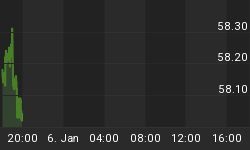First, I have to begin with a chart of the Industrials and the Transports. At this level we still have two non-confirmations. The first non-confirmation occurred when the Transports moved below their June lows. When the Industrials refused to confirm this downside break, the first short-term non-confirmation came to be. This non-confirmation is noted in blue. As the Transports continued lower into August, the Industrials moved higher and this price movement has created a second short-term non-confirmation, as is noted in red. Therefore, we have both a short-term downside and a short-term upside non-confirmation in place today. The bottom line here is that, according to Dow theory, when the two averages are not in agreement, they are "shouting be careful."

Next, I have plotted a chart of the Industrial's going back to the 2002 low. The indicator in the upper window is my intermediate-term NYSE Advance/Decline line. Notice that this indicator peaked in June 2003 and that each successive Secondary price advance since has occurred with this indicator making progressively lower and lower peaks. At present, this indicator has pushed back up against the downward sloping trend line created by the previous peaks. But, let me also point out that this is occurring as the "Summer Rally" is unfolding and this in and of itself is telling us that the Advance/Decline data has not confirmed the "Summer Rally."

Now, I know that many will argue that you can't use or rely on the NYSE internal strength data anymore because of the non-equity related additions to the NYSE. Personally, I have my doubts about that and here's why. Below I have plotted my intermediate-term Advance/Decline line on the AMEX. Note that the results are very very similar to the NYSE Advance/Decline line. So, even if you are reluctant to believe the NYSE data, the AMEX data is very hard to argue with.

Just for fun, lets also take a look at the Nasdaq data. In the chart below, I have plotted the Nasdaq 100 along with my intermediate-term Nasdaq Advance/Decline line. Here too, the results are very similar to the NYSE and the AMEX data in that here we also saw the peak in June 2003 and divergent peaks ever since. It should now be obvious that the Advance/Decline data has been fading across the board and continues fading today. As a side note I also want to point out that with both the AMEX and the NYSE Advance/Decline data closely resembling the NYSE data, I have a hard time with the argument that the NYSE data is so corrupt that it can't be used.

Another internal strength item of sorts that I want to look at is the number of stocks making new 52-week highs. In the chart below I have plotted a chart of the Industrials and in the upper window I have plotted my intermediate-term NYSE New High/New Low indicator. This indicator peaked in January 2004 and has been forming divergences since.

In the next chart below I have plotted my intermediate-term New High/New Low indicator for the AMEX. Here again, the results are very similar to what we are seeing in the NYSE data. Here this indicator peaked in February 2004 and has since formed divergences with price.

For the sake of being thorough, I have also included a chart of the NDX along with the intermediate-term Nasdaq New High/New Low indicator. Here the results are not exactly like that seen by the NYSE and the AMEX, but it's still not exactly healthy either. Here the peak came in February 2004. The advance into early 2006 did manage to carry this indicator up above its August 2005 high, but still wasn't good enough to better the December 2004 peak. Since this indicator rolled over earlier this year it has dropped down below its previous two lows.

Understand that these internal measures of the market do not provide us with any sort of specific timing and they are not presently telling us that the market is going up or down. No, these indicators are simply signs of the times and are telling us that this advance continues to be weak internally. Think about it. If the market is advancing and the number of advancing issues over declining issues continues to shrink, what does this tell you? Another reflection of this is being seen by the number of stocks making new 52-week highs, which is also shrinking. It's simple folks. The market has been holding up with fewer and fewer participants. This cannot and will not continue forever. The massive liquidity infusion we have experienced over the last few years has helped hold the markets up, but they have floated up largely on that liquidity rather than underlying strength. This is not the sign of a healthy market.
The market will rollover on its own weight and when that begins to occur it will be reflected in price and other technical indicators. In addition to the poor internals, we also have the Dow theory non-confirmations in the making, which serves as another hint that something is wrong. All the while my 2006 forecast that was based on trend quantifications way back in late January remains on track. If you are interested in a statistical and technical based source that also utilizes Dow theory and provides statistical probabilities as to what should occur, then Cycles News & Views may be for you. I also provide web-based updates giving specific short and intermediate-term turn points on the stock market, gold, bonds and the dollar, utilizing my Trend and Cycle turn Indictors. The Trend and Cycle Turn Indicators keep us on track with specific turn points and guides us in regard to our longer-term forecasts. The September issue is now available and in it I give all of the updated statistical probabilities and specific expectations for the stock market for the rest of 2006 and into 2007. A subscription also includes short-term updates three nights a week. Please see www.cyclesman.com/testimonials.htm.















